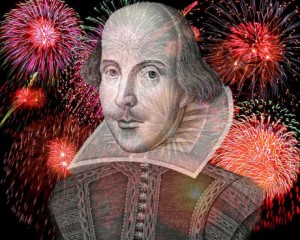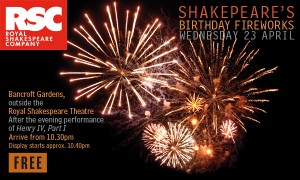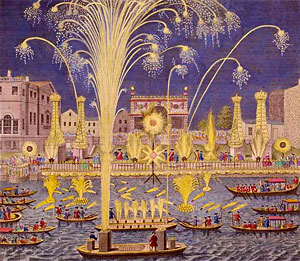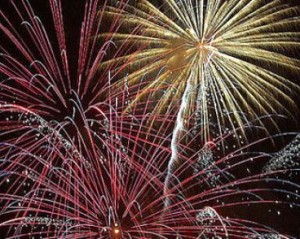 Nothing is more likely to appeal to people regardless of age, language, or politics than a firework display, and the one that’s to be put on from the Royal Shakespeare Theatre on 23rd April will be an exciting start for the town’s celebrations of Shakespeare’s 450th birthday.
Nothing is more likely to appeal to people regardless of age, language, or politics than a firework display, and the one that’s to be put on from the Royal Shakespeare Theatre on 23rd April will be an exciting start for the town’s celebrations of Shakespeare’s 450th birthday.
The earliest recorded display of fireworks in England took place on the wedding day of Henry VII in 1486, an event which ended the conflicts of the Wars of the Roses. Queen Elizabeth 1 enjoyed fireworks and the entertainments put on for her 1575 visit to Robert Dudley’s Kenilworth Castle included a magnificent firework display which the 11 year old William Shakespeare may have seen.
In Love’s Labour’s Lost the Spaniard Don Armado is asked to organise royal entertainments, including fireworks:
the king would have me
present the princess … with some
delightful ostentation, or show, or pageant, or
antique, or firework.
Fireworks could have been set off on stage in Shakespeare’s period, but gunpowder was always dangerous: it was a cannon, set off during the first performance of Henry VIII, that caused the burning down of the Globe Theatre in 1613. And everyone had cause to be wary after the 1605 Gunpowder Plot that very nearly blew up Parliament.
This history of fireworks includes a description of the sort of thing Shakespeare might have seen:
From 1500-1700, the most popular type of firework was the “dragon”. The massive device consisted of a wooden framework which was covered in painted paper-maché scales. Inside, it was loaded with fountains, firecrackers, and rockets, some of which would shoot out of the mouth to make it “breathe fire”.
Fireworks were first used to commemorate Shakespeare during the 1769 Jubilee in Stratford-upon-Avon. They had by then become popular public displays.
The discovery of “quick match” – a fast-burning fuse made by putting regular fuse into a small, continuous paper tube – gave firemasters the ability to ignite many fireworks simultaneously, and enabled the construction of set pieces. Set pieces are giant pictures/words made from hundreds of small burning torches, which were often created in the likeness of popular figures such as royalty.
In their book Amazing Monument, Brown and Fearon described how the Italian Signor Domenico Angelo ” arrived from London with two special wagon-loads of rockets, squibs and fairy lamps and busily toiled that Stratford might be “all lit up”.” With rain falling heavily, “through the dreary twilight the untiring Signor Angelo sped like Lucifer touching off his rockets, set-pieces, and revealing his “illuminated transparencies” at the Rotunda and the Birthplace. There was plenty of time to study the symbolic designs thus offered to the view” as the fireworks failed to go off.
Fireworks made another appearance in 1816 for the first major celebration of the birthday itself on 23 April, and again in 1827. In 1830 there were two displays as competing Shakespeare Clubs vied with each other to produce the most spectacular celebrations. One advertised “The grandest and most truly unequalled display of Fireworks ever witnessed, … under the direction of Mr Southby, artist of The Royal Gardens, Vauxhall, London”. The high point was “the grand illuminated “Choragic Monument of Shakespeare, of the height of thirty feet… in the centre of which was introduced a most beautiful Transparent Portrait of the Immortal Bard”.
For the tercentenary on 23 April 1864 a “grand display of fireworks by Mr Darby, the celebrated Pyrotechnist” took place. The Illustrated Times of 30 April called it “a brilliant display of fireworks… in an open place adjoining the town” and the programme listed no fewer than sixty-three individual items with a “Grand concluding Piece, made expressly for the occasion: the Vision of Shakespeare, formed of many thousand Lights, and gigantic Transparent Effects, supported by Ornamental Pedestals in various coloured fires…forming a Bouquet of the most beautiful Fires known in the Pyrotechnic Arts.”
For the 1873 celebrations a “grand pyrotechnic display…by Mr J Follows of Stafford” took place at the Market Cross. The forty different items included a “magnificent emblematic piece, … showing a medallion portrait of Shakespeare (after the Stratford bust), executed in brilliant lance work”, the grand finale “a representation of Shakespeare’s house in brilliant stars, backed and surrounded by waterfalls of Roman candles… exhibiting beautiful fountains of Chinese fire, the most imposing tableau ever witnessed in the Pyrotechnic art”.
The town was also celebrating its new gas supply. At the Town Hall gas lights encircled the 1769 Shakespeare statue dedicated by Garrick, with “a circle of gas jets round the statue of Shakespeare, with a star at the summit and the initials WS at the foot.” With gas being provided free on the day around the town, over 500 gas lights were to be seen.
 The sad thing about all these displays is that although the detailed descriptions sound intriguing, we’ve really no idea what they were like. It’s one of the ephemeral delights of fireworks that like theatrical performances they “leave not a wrack behind”. The RSC’s follows in a long tradition of Shakespeare firework displays, but I’m hoping this one will be recorded so people around the world will be able to feel part of the celebrations. In addition to traditional pyrotechnics, the special birthday display will feature an 8 metre high frame (note this is smaller than the 1830 one!) depicting Shakespeare’s face, which will light up in ‘stars’ made of fireworks. It will be based on the Droeshout engraving of Shakespeare from the First Folio, and reminiscent of Juliet’s lines about Romeo.
The sad thing about all these displays is that although the detailed descriptions sound intriguing, we’ve really no idea what they were like. It’s one of the ephemeral delights of fireworks that like theatrical performances they “leave not a wrack behind”. The RSC’s follows in a long tradition of Shakespeare firework displays, but I’m hoping this one will be recorded so people around the world will be able to feel part of the celebrations. In addition to traditional pyrotechnics, the special birthday display will feature an 8 metre high frame (note this is smaller than the 1830 one!) depicting Shakespeare’s face, which will light up in ‘stars’ made of fireworks. It will be based on the Droeshout engraving of Shakespeare from the First Folio, and reminiscent of Juliet’s lines about Romeo.
Take him and cut him out in little stars,
And he will make the face of heaven so fine
That all the world will be in love with night
And pay no worship to the garish sun.
The display starts at 10.40 and can be seen from the Bancroft Gardens outside the RST. It should be one to remember.



